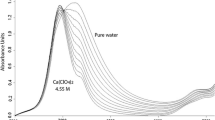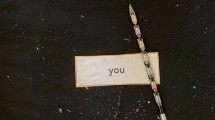Conclusion
The study of the interaction of calcium chloride with sodium carbonate reveals the following facts:
-
1.
The Liesegang phenomenon may take place in the absence of a limiting initial colloidal medium, the interaction of the electrolytes constituing a source of colloidal matter.
-
2.
This colloidal dispersion may be stable both in air and in an aqueous medium. A wide range of periodic formations come into being under conditions rendering the colloidal state transitory in character. These structures comprise both compact (asbestos-like layers and arboreal growth) and dispersed (opacity bands and streamers) forms.
-
3.
The conditions of reaction leading to the dispersed colloidal system strongly support the possibility of these serving as the basis of the colloidal substrate in photosynthesis.
Similar content being viewed by others
Bibliography
Copisarow, Koll. Zeitschr., 1931,54, 257; J. Phys, Chem., 1932,36, 752.
Hatschek, Proc. Roy. Soc., 1919,95A, 303.
Böttger, J. prakt. Chem., 1837,10, 60;
Mulder, Ibid., 1841,22, 41;
Hunefield, Ibid. 1828, 23;
Leduc, Compt. Rend., 1905,141, 280; 1906,143, 842.
Copisarow, J. Chem. Soc., 1927, 230; Koll. Zeitschr., 1929,47, 60.
Sen, Zeitschr. Anorg. Chem., 1937,234, 63.
Copisarow, J. Chem. Soc., 1923,123, 785.
Usher andPriestley, Proc. Roy. Soc., 1911, B 84, 101;
Baly, Heilbron andBarker, J. Chem. Soc., 1921,119, 1025;
Baly, Rep. Brit. Assoc. Adv. Sc., 1930;
Mezzadroli andCollaborators, Atti. Accad. Lincei., 1927,6, 160; Gazetta, 1929,59, 305;
Dhar andCo-Workees, J. Phys. Chem., 1925,29, 926; 1931,35, 1418; 1932,36, 567; Trans. Far. Soc., 1931,27, 554; Nature, 1932, 129, 205;130, 313; 1933,132, 819; 1934,134, 331; J. Ind. Chem. Soc., 1934,11, 145;
Yoe andWingard, J. Chem. Phys., 1933,1, 886.
Baly, Nature, 1937,140, 930.
Author information
Authors and Affiliations
Additional information
Preliminary Notes — Nature, 1933,132, 67; 1936,138, 509.
Rights and permissions
About this article
Cite this article
Copisarow, M. The liesegang phenomenon as a source of colloidal matter. Protoplasma 30, 258–264 (1938). https://doi.org/10.1007/BF01613752
Received:
Published:
Issue Date:
DOI: https://doi.org/10.1007/BF01613752




